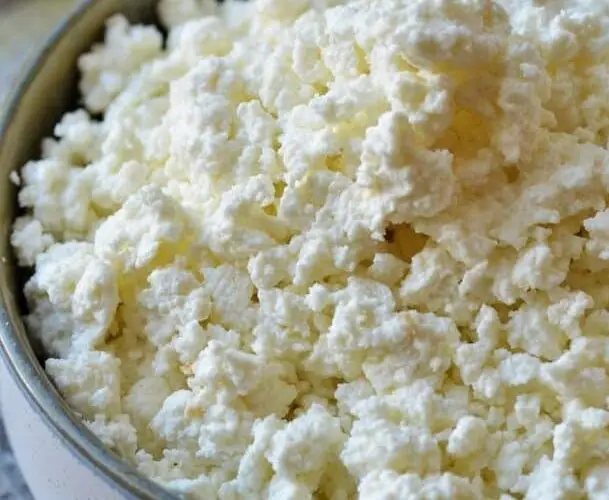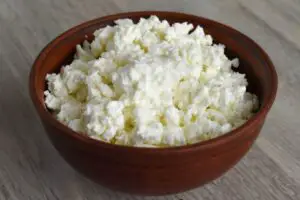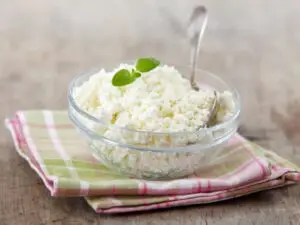Chenna is a soft, juicy, crumbly product made from curdled milk solids. It is produced by adding an acidic substance, such as lemon, lime, or vinegar, to milk to cause it to curdle. The excess whey is then drained away, leaving just enough to keep the cheese wet.
It’s wonderful to use chenna for desserts and to serve it with bread and chutney. Making fresh and soft chenna at home is quite simple. It practically melts on your tongue since it is so soft and crumbly.
The term “chenna” describes soft, crumbly milk solids that have curdled. After boiling the milk, we use a cheesecloth or sieve to remove the extra whey. These cheese curds, known as chenna, can either be saved or pressed into paneer.
This is made with Full-fat Milk and Lemon Juice. This is used in the making of Indian sweets like rasgullas, and kalakand.
Versatility in Indian Sweets
Chenna is celebrated for its versatility in Indian cuisine, particularly in the realm of sweets. It serves as the base for a wide range of delectable desserts that vary in taste, texture, and presentation. Some popular Chenna-based sweets include Rasgulla, Sandesh, Chenna Poda, and Chum Chum.
Ingredients for chenna
- 1-liter full-fat milk
- 1 lemon
Instruction for chenna
- You’ll need 1.5 tablespoons of lemon juice, so squeeze several lemons. Cover a large bowl with a sieve made of muslin linen.
- Put milk in a pot and heat it up quickly. Bring it to a boil. When it boils, turn off the heat and let the mixture rest for a minute.
- Add the lemon juice and gently combine. It will curdle the milk. When the milk solids have fully curdled and a greenish whey separates from the milk. Use the sieve to strain it.
- Now thoroughly wash the chenna in a large bowl of cold water. Rinse it three times in fresh water.
- Now gently compress it between your hands to squeeze out any extra whey water. Make a knot, hang it over the faucet, and let it drain for 30 minutes. I occasionally squeezed to speed things up.
- Now the chenna is done, this is a soft chenna recipe, you can use them to make different sweet
notes
- Fresh milk: Use fresh whole milk to make Chhena for the best results. Avoid using ultra-pasteurized milk, as it may not curdle properly.
- Lemon juice or vinegar: To curdle the milk, you can use lemon juice or white vinegar. Add it gradually until the milk separates into curds and whey.
- Straining the curds: Once the milk has curdled, strain it through a muslin cloth or cheesecloth to separate the curds from the whey. Rinse the curds under cold water to remove any lemony or acidic taste.
- Pressing the curds: Tie the cloth with the curds and hang it for a few hours to drain excess moisture. You can also place a heavy object on top to press it gently, which helps in achieving a firm texture.
Variations:
- Kheer (Chhena Payas): Instead of using rice, substitute the traditional rice kheer with grated Chhena. Cook it with milk, sugar, and cardamom powder until it thickens. Add nuts, saffron strands, and rose water for added flavor.
- Chhena Jhili: It is a popular sweet from Odisha. Mix the Chhena with semolina (sooji), sugar, and a pinch of baking powder. Shape the mixture into small oval-shaped balls and deep-fry until golden brown. Soak the fried jhilis in sugar syrup for a delectable sweetness.
- Chhena Poda: This is a mouthwatering dessert from Odisha. Combine Chhena with sugar, cardamom powder, chopped nuts, and a pinch of baking powder. Bake the mixture in a greased pan until it turns golden brown and sets. It has a caramelized outer layer and a soft, spongy interior.
- Chhena Murki: It is a delightful sweet from Rajasthan. Shape the Chhena into small bite-sized balls and deep-fry them until golden brown. Soak the fried Chhena balls in sugar syrup until they absorb the sweetness. Garnish with pistachios or almonds for added crunch.
FAQs
Q: Can I use store-bought paneer instead of chhena?
A: While paneer is similar to chhena, they have slight differences in texture and moisture content. Chhena is softer and moister than paneer, making it more suitable for certain sweets. However, you can use paneer as a substitute in some recipes.
Q: What sweets can I make with chhena?
A: Chhena is used in a variety of Indian sweets such as rasgulla, Sandesh, ras malai, chhena murky, chhena poda, chhena Jhili, and more.
Q: Can I make chhena without using lemon juice or vinegar?
A: Lemon juice or vinegar is commonly used to curdle the milk and separate the curds. However, you can also use citric acid or sour yogurt as alternatives.
Q: How do I store chhena?
A: Chhena can be stored in the refrigerator for 2-3 days. Make sure to keep it covered in a container to prevent it from drying out.
Q: Can I freeze chhena?
A: Yes, you can freeze chhena. Wrap it tightly in plastic wrap or place it in an airtight container before freezing. Thaw it in the refrigerator overnight before using it
Q: Can I make savory dishes with chhena?
A: While chhena is predominantly used in sweet dishes, you can also experiment with savory recipes. It can be crumbled and used in dishes like chhena bhurji (scrambled chhena) or added to curries for a creamy texture.
In Conclusion
Chenna is the heart of countless Indian sweet delicacies, and learning how to make it at home is a rewarding culinary experience. With this versatile ingredient, you can explore a world of flavors and create sweet treats that will impress your family and friends. So, gather your ingredients, follow the simple steps, and embark on a delightful journey into the world of Chenna-based desserts.
Nutrition
| Calories | 339kcal |
| Fat | 17.27g |
| Sodium | 130mg |
| Protein | 8g |
| Calcium | 300mg |
You Might Also Like:
follow us on instagram, facebook and youtube




[…] How to make Chenna […]
[…] How to make Chenna […]
[…] How to make chenna […]
[…] How to make chenna […]
[…] How to make chenna […]